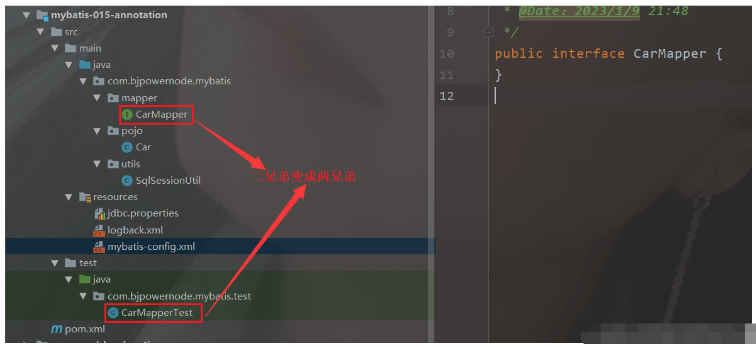今天小编给大家分享一下MyBatis注解式开发映射语句怎么使用的相关知识点,内容详细,逻辑清晰,相信大部分人都还太了解这方面的知识,所以分享这篇文章给大家参考一下,希望大家阅读完这篇文章后有所收获,下面我们一起来了解一下吧。
MyBatis中也提供了注解式开发⽅式,采⽤注解可以减少Sql映射⽂件的配置。 当然,使⽤注解式开发的话,sql语句是写在java程序中的,这种⽅式也会给sql语句的维护带来成本。
使⽤注解编写复杂的SQL是这样的:
@Update("<script> update table_name set grade='三年级'”+
" <if test=\ "name != null\"> , name = #{name} </if> ”+
" <if test=\ "sex != null\"> , sex = #{sex}</if>”+
" where num = #{num}</script>")
void update(Student student);原则:简单sql可以注解,复杂sql使⽤xml!使用注解式开发以后三兄弟之一的SqlMapper.xml文件就不需要了!

二兄弟之一CarMapper接口,用来编写方法
使用@Insert的注解方式,在注解上就可以写上SQL语句,对于SQL语句当中的变量就是pojo类Car对应的变量名
package com.bjpowernode.mybatis.mapper;
import com.bjpowernode.mybatis.pojo.Car;
import org.apache.ibatis.annotations.Insert;
public interface CarMapper {
// 使用注解式开发,插入数据
@Insert("insert into t_car values(null,#{carNum},#{brand},#{guidePrice},#{produceTime},#{carType})")
int insert(Car car);
}二兄弟之二CarMapperTest,用来测试
package com.bjpowernode.mybatis.test;
import com.bjpowernode.mybatis.mapper.CarMapper;
import com.bjpowernode.mybatis.pojo.Car;
import com.bjpowernode.mybatis.utils.SqlSessionUtil;
import org.apache.ibatis.session.SqlSession;
import org.junit.Test;
public class CarMapperTest {
@Test
public void testInsert(){
SqlSession sqlSession = SqlSessionUtil.openSession();
CarMapper mapper = sqlSession.getMapper(CarMapper.class);
// 创建Car对象
Car car = new Car(null, "666", "丰田霸道", 32.0, "2023-1-9", "燃油车");
int count = mapper.insert(car);
System.out.println(count);
sqlSession.commit();
sqlSession.close();
}
}执行结果:

二兄弟之一CarMapper接口,用来编写方法
package com.bjpowernode.mybatis.mapper;
import com.bjpowernode.mybatis.pojo.Car;
import org.apache.ibatis.annotations.Insert;
public interface CarMapper {
// 使用注解式开发,删除数据
@Delete("delete from t_car where id = #{id}")
int deleteById(Long id);
}二兄弟之二CarMapperTest,用来测试
package com.bjpowernode.mybatis.test;
import com.bjpowernode.mybatis.mapper.CarMapper;
import com.bjpowernode.mybatis.pojo.Car;
import com.bjpowernode.mybatis.utils.SqlSessionUtil;
import org.apache.ibatis.session.SqlSession;
import org.junit.Test;
public class CarMapperTest {
@Test
public void testDeleteById(){
SqlSession sqlSession = SqlSessionUtil.openSession();
CarMapper mapper = sqlSession.getMapper(CarMapper.class);
int count = mapper.deleteById(40L);
System.out.println(count);
sqlSession.commit();
sqlSession.close();
}
}执行结果:

二兄弟之一CarMapper接口,用来编写方法
package com.bjpowernode.mybatis.mapper;
import com.bjpowernode.mybatis.pojo.Car;
import org.apache.ibatis.annotations.Insert;
public interface CarMapper {
// 使用注解式开发,更新数据
@Update("update t_car set car_num=#{carNum},brand=#{brand},guide_price=#{guidePrice},produce_time=#{produceTime},car_type=#{carType} where id = #{id}")
int update(Car car);
}二兄弟之二CarMapperTest,用来测试
package com.bjpowernode.mybatis.test;
import com.bjpowernode.mybatis.mapper.CarMapper;
import com.bjpowernode.mybatis.pojo.Car;
import com.bjpowernode.mybatis.utils.SqlSessionUtil;
import org.apache.ibatis.session.SqlSession;
import org.junit.Test;
public class CarMapperTest {
@Test
public void testUpdate(){
SqlSession sqlSession = SqlSessionUtil.openSession();
CarMapper mapper = sqlSession.getMapper(CarMapper.class);
// 创建Car对象,根据id进行更新
Car car = new Car(34L, "666", "丰田霸道", 32.0, "2023-1-9", "燃油车");
int count = mapper.update(car);
System.out.println(count);
sqlSession.commit();
sqlSession.close();
}
}执行结果:

二兄弟之一CarMapper接口,用来编写方法
package com.bjpowernode.mybatis.mapper;
import com.bjpowernode.mybatis.pojo.Car;
import org.apache.ibatis.annotations.Insert;
public interface CarMapper {
// 使用注解式开发,查询数据
@Select("select * from t_car where id = #{id}")
Car selectById(Long id);
}二兄弟之二CarMapperTest,用来测试
package com.bjpowernode.mybatis.test;
import com.bjpowernode.mybatis.mapper.CarMapper;
import com.bjpowernode.mybatis.pojo.Car;
import com.bjpowernode.mybatis.utils.SqlSessionUtil;
import org.apache.ibatis.session.SqlSession;
import org.junit.Test;
public class CarMapperTest {
@Test
public void testSelectById(){
SqlSession sqlSession = SqlSessionUtil.openSession();
CarMapper mapper = sqlSession.getMapper(CarMapper.class);
Car car = mapper.selectById(41L);
System.out.println(car);
sqlSession.close();
}
}执行结果:

我们知道数据库表中的字段和pojo类的属性名有的是不一样的,我们之所以能够完整的查出数据,是因为在核心配置文件mybatis-config.xml当中配置了:启用驼峰命名⾃动映射
<!--启⽤驼峰命名⾃动映射-->
<settings>
<setting name="mapUnderscoreToCamelCase" value="true"/>
</settings>如果我们不启用,不对应的字段就是null,查询的数据如下:

那还有什么办法呢?还可以使用@Results注解!
注:从这里也能看出,使用注解的方式开发,对于简单点的SQL还行,对于稍微复杂的查询语句就太麻烦了!
package com.bjpowernode.mybatis.mapper;
import com.bjpowernode.mybatis.pojo.Car;
import org.apache.ibatis.annotations.*;
public interface CarMapper {
// 使用注解式开发,查询数据
@Select("select * from t_car where id = #{id}")
@Results({
@Result(property = "id",column = "id"),
@Result(property = "carNum",column = "car_num"),
@Result(property = "brand",column = "brand"),
@Result(property = "guidePrice",column = "guide_price"),
@Result(property = "produceTime",column = "produce_time"),
@Result(property = "carType",column = "car_type"),
})
Car selectById(Long id);
}这样计算我们不启用驼峰命名⾃动映射,也能正常查询数据

以上就是“MyBatis注解式开发映射语句怎么使用”这篇文章的所有内容,感谢各位的阅读!相信大家阅读完这篇文章都有很大的收获,小编每天都会为大家更新不同的知识,如果还想学习更多的知识,请关注亿速云行业资讯频道。
亿速云「云服务器」,即开即用、新一代英特尔至强铂金CPU、三副本存储NVMe SSD云盘,价格低至29元/月。点击查看>>
免责声明:本站发布的内容(图片、视频和文字)以原创、转载和分享为主,文章观点不代表本网站立场,如果涉及侵权请联系站长邮箱:is@yisu.com进行举报,并提供相关证据,一经查实,将立刻删除涉嫌侵权内容。